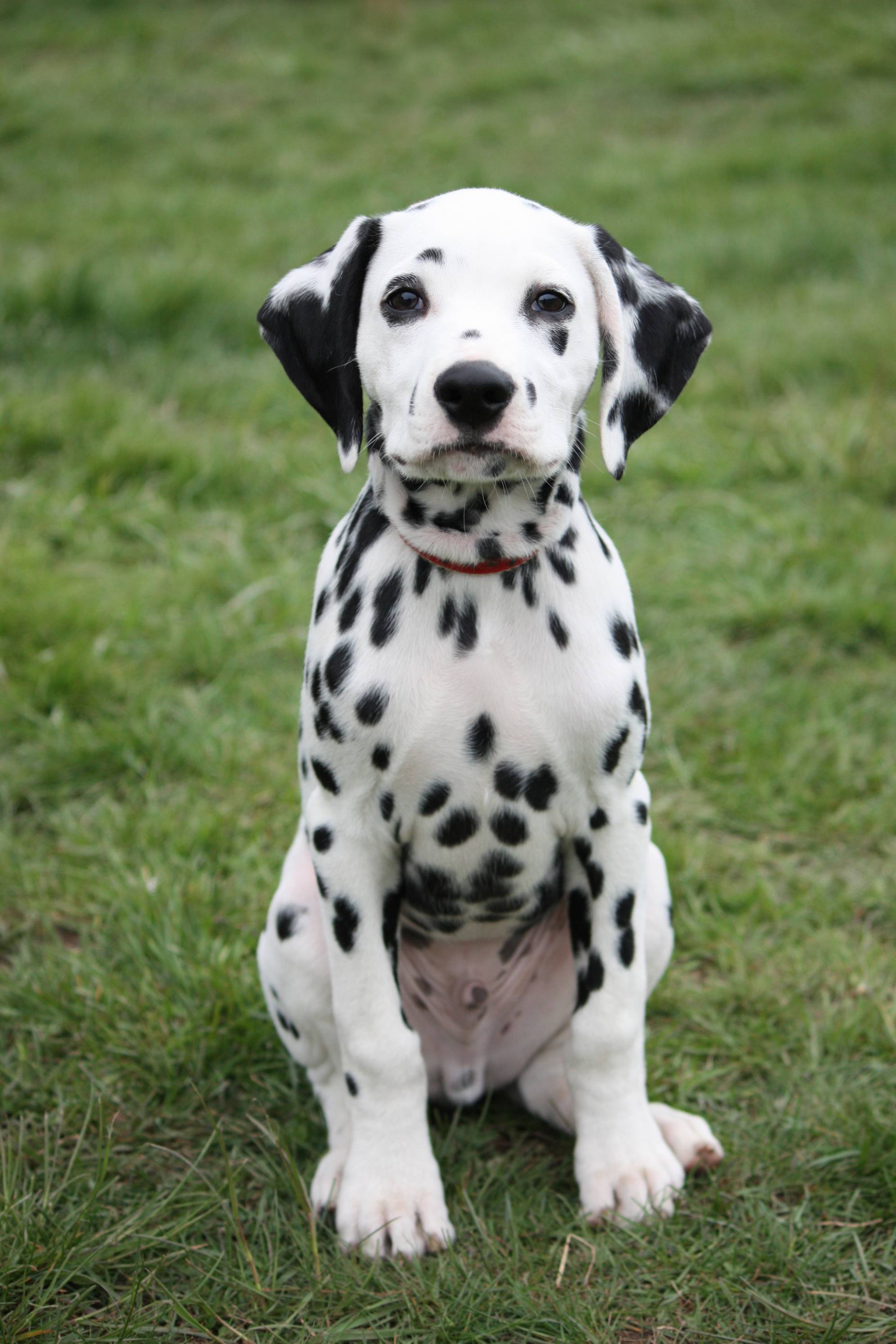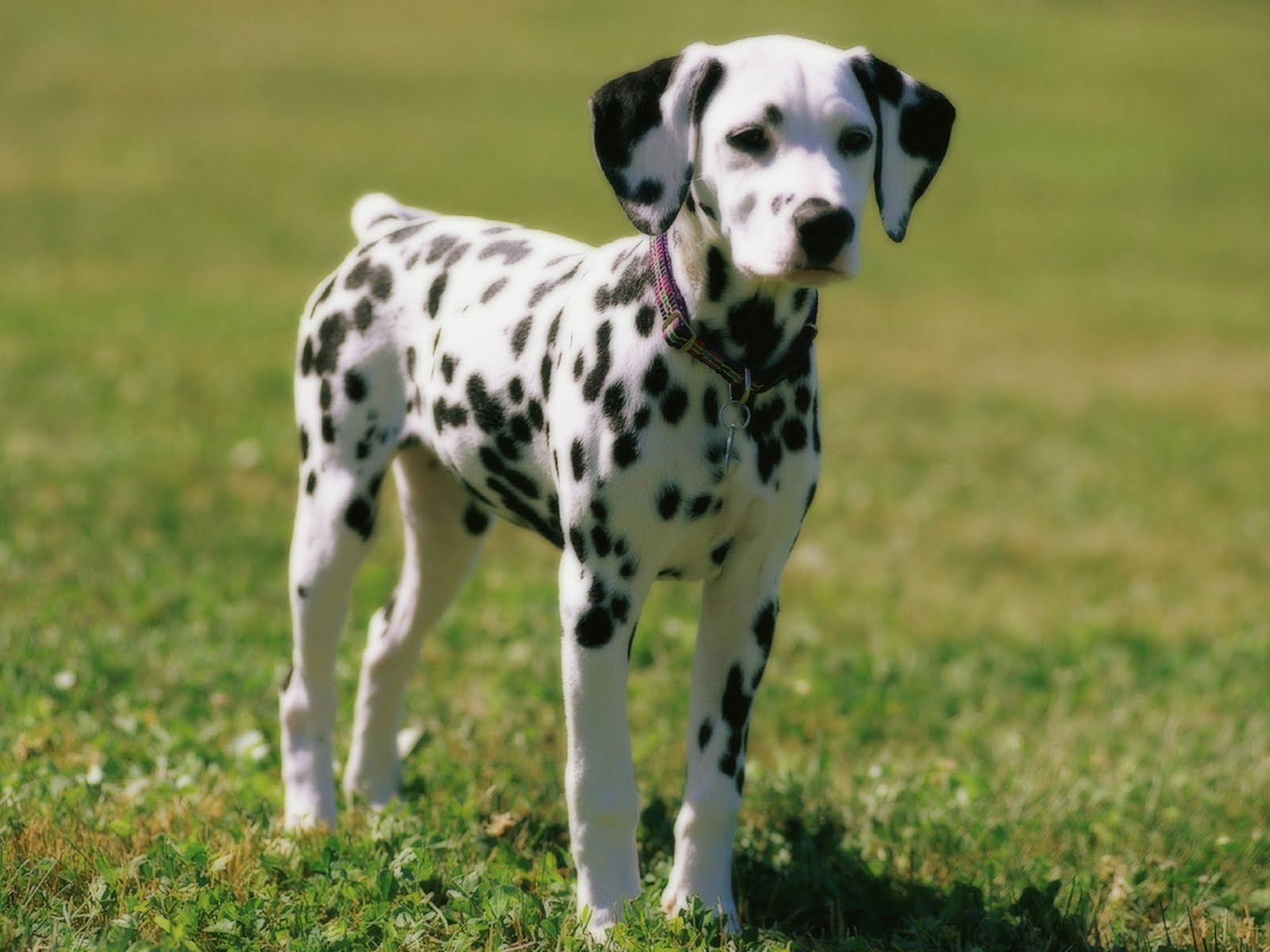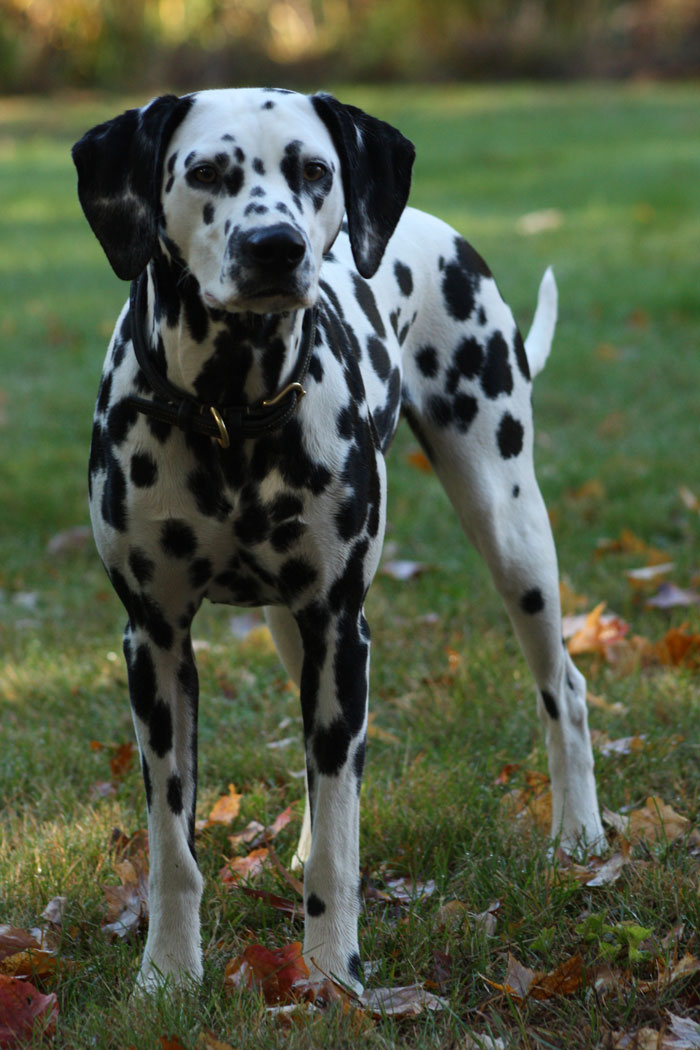
The Breed History
Artwork depicts a dog of this type back into antiquity in various
countries, especially India but the first written records date from
the mid 1800s in the region of Dalmatia in western Yugoslavia.
Their popularity surged after the Disney movie One Hundred and
One Dalmatians.
Breeding for Function
Though the breed's utility as a dog accompanying the coach or fire
truck of old times is well known, this dog is much more versatile,
having been of service in sentry, draft, circus, sheep herding and
vermin control. Also less commonly appreciated are the strengths of
this breed as a versatile hunter dog performing scenting, bird dog,
and retriever functions. Also was used in pack-based hunting for
larger game such as wild boar and deer. Today, they serve primarily
in companionship roles.
Physical Characteristics
Height at Withers: 19-23" (48-58.5 cm)
Weight: 50-55 lb (23-25 kg)
Coat: Born pure white as puppies, their spots develop as they
mature starting at two weeks of age. The flat, short glossy coat
consists of fine straight hairs and is black and white or liver and
white (the latter is uncommon and is of recessive inheritance).
Markings are well demarcated from the white, should not overlap,
and should be round with specified minimum and maximum size.
If patches of color are present from birth and they have irregular
margins-they are a disqualification.
Longevity: 12-14 years
Points of Conformation: As one would expect in a coach dog,
a strong, smooth, speedy but effortless ground covering stride
and presence of mind and judgment around horses and traffic
are paramount. Endurance is a breed hallmark. They are square in
conformation and have a muscular, lithe, trim build. They have an
alert expression. The skin on the skull is tight (unwrinkled), eyes are
deep set and rounded, brown or blue colored and medium-sized.
Palpebral margins should be completely pigmented. Ears taper to
rounded tips and are moderately sized, pendulous and triangular
in shape, lying close to the head. The leather is fine. The stop is
moderate, skull is flat, muzzle blocky, and the nose is black or brown
to match the coat. The lips are close and dry. The neck is fairly long,
not throaty, and is slightly arched. The topline smoothly descends
towards the rear. The thorax is deep, ribs are well sprung, and the
abdomen has a moderate tuck up. The curved tail tapers at the tip
and reaches the tarsus at rest. Limbs are straight boned, dewclaws
may be removed. Feet are very compact with very tough thick pads.
Strong nails match the coat color or are white, and the toes are
very well arched up.
Recognized Behavior Issues and Traits
Reported breed traits include: Highly intelligent, loyal and quick to
protect home and family, good watchdog, quick to learn, very high
activity levels (exuberant) and high exercise needs, extroverted,
playful and sensitive.
They need only low grooming levels and are moderate shedders.
Inter-male aggression is sometimes a problem, as can be snippiness
and aggression towards people. They can be a bit too lively for very
small children but good for older quiet children if socialized. They
are generally aloof with strangers and some lines may be a bit high
strung. They need human companionship and need activities to keep
them busy or they may develop boredom vices.
Normal Physiologic Variations
Hyperuricosuria (Abnormal Purine Metabolism): All Dalmatians
are homozygous recessive for a mutation in the SLC2A9 gene
causing abnormal purine metabolism and hyperuricosuria. This
can predispose to urate bladder stones and Dalmatian bronzing
syndrome. A Dalmatian back-cross project begun in 1973 with a
breeding between a Dalmatian and an English Pointer reintroduced
the normal allele for purine metablism. Repeated matings back to
Dalmatians over 13+ generations have produced phenotypically
normal Dalamtians that carry the normal allele. These dogs are now
registerable as Dalamtians by the UKC, and the AKC.
Dal Red Blood Cell Type: Some Dalmatians lack a red blood cell
antigen that causes them to develop novel IgG alloantibodies
post-transfusion. These dogs are at risk of delayed and acute
hemolytic reactions after subsequent transfusions. Crossmating
should be performed for all Dalmatian transfusions.
Drug Sensitivities
None reported
Inherited Diseases
Deafness: Congenital deafness can be unilateral or bilateral.
Diagnosed by BAER testing. Strain reports total (uni or bilateral)
deafness frequency of 29.9% based on BAER testing. 21.9% of
all Dalmatians test unilaterally deaf, and 8.0% test bilaterally
deaf. Heritability is estimated at 0.73-0.75 with a polygenic mode
of inheritance. Dorn reports a 409.34x odds ratio versus other
breeds. Blue eyed Dalmatians (only allowed in the US standard, not internationally) have a much higher incidence of deafness than
brown eyed dogs. Deafness and blue eye color are both associated
with the MITF gene.
Hip Dysplasia: Polygenically inherited trait causing degenerative
joint disease and hip arthritis. OFA reports 4.6% affected.
Elbow Dysplasia: Polygenically inherited trait causing elbow
arthritis. OFA reports 0.4% affected.
Patella Luxation: Polygenically inherited laxity of patellar
ligaments, causing luxation, lameness, and later degenerative joint
disease. Treat surgically if causing clinical signs. Too few Dalmatians
have been screened by OFA to determine an accurate frequency.
Disease Predispositions
Urate Urolithiasis: All Dalmatians are affected with hyperuricosuria,
and urate crystals are uniformly formed in the breed. Reports
show that 34% of male Dalmatians go on to form urate stones.
Male Dalmatians have a 14.0x odds ratio for forming urate stones
versus female Dalmatians. The heritability of urate bladder stone
formation is reported to be 0.87. Dorn reports a 9.03x odds ratio
versus other breeds. Treatment is with surgical removal, and
prevention with medications. Reported at a frequency of 3.0% in
the 2002 Dalmatian Club of America Health Survey.
Hypothyroidism: Inherited autoimmune thyroiditis. 16.3% positive
for thyroid autoantibodies based on testing at Michigan State
University. (Ave. for all breeds is 7.5%) Reported at a frequency of
3.0% in the 2002 Dalmatian Club of America Health Survey.
Allergic Dermatitis: Inhalant or food allergy. Presents with pruritis
and pyotraumatic dermatitis. Dalmatians have a significantly
increased risk for atopy versus other breeds. Reported at a
frequency of 9.0% in the 2002 Dalmatian Club of America Health
Survey.
Dalmatian Bronzing Syndrome (Xanthomatosis): Skin condition
in dalmatians characterized by a patchy haircoat and bronze hue
with folliculitis. This appears to be related to the excessive uric
acid excretion that occurs in the Dalmatian. Not all Dalmatians are
affected, even though all have elevated uric acid excretion.
Distichiasis: Abnormally placed eyelashes that irritate the cornea
and conjunctiva. Can cause secondary corneal ulceration. Identified
in 2.37% of Dalmatians CERF-examined by veterinary ophthalmologists
between 2000-2005.
Corneal Dystrophy: The breed can have an epithelial/stromal form
of corneal dystrophy. Age of onset 2-5 years. Identified in 2.37%
of Dalmatians CERF-examined by veterinary ophthalmologists
between 2000-2005.
Idiopathic Epilepsy: Inherited seizures. The breed is reported
with both generalized and partial-onset seizures. 18.2% start as
generalized seizures, and 36.4% begin as partial seizures (with the
rest mixed) at a mean age of 3.2 years. 91% of affected Dalmatians
progress to generalized seizures. Dorn reports a 4.05x odds ratio
versus other breeds. Reported at a frequency of 2.0% in the 2002
Dalmatian Club of America Health Survey. Control with anti-seizure
medication. Unknown mode of inheritance.
Demodicosis (Generalized): Demodectic mange has an underlying
immunodeficiency in its pathogenesis. Dorn reports a 1.42x odds
ratio versus other breeds. Reported at a frequency of 2.0% in the
2002 Dalmatian Club of America Health Survey.
Behavioral Problems: Dalmatians are over-represented in
veterinary behavioral consultations versus other breeds in all
categories, including aggression, anxiety, house soiling, and
phobias.
Glaucoma: Primary, narrow angle glaucoma occurs in the breed.
Can cause blindness due to retinal damage, or secondary lens
luxation. Screen with gonioscopy and tonometry. Reported
increased incidence in Dalmatians versus other breeds. CERF does
not recommend breeding any Dalmatian with glaucoma.
Cataracts: Intermediate cataracts predominate in the breed.
Reported in 1.69% of Dalmatians CERF examined by veterinary
ophthalmologists between 2000-2005. CERF does not recommend
breeding any Dalmatian with a cataract.
Iris Coloboma: Developmental defect of the iris. Identified in
1.52% of Dalmatians CERF-examined by veterinary ophthalmologists
between 2000-2005. CERF does not recommend breeding any
Dalmatian with a coloboma.
Persistent Pupillary Membranes: Strands of fetal remnant
connecting; iris to iris, cornea, lens, or involving sheets of tissue. The
later three forms can impair vision, and dogs affected with these
forms should not be bred. Identified in 1.18% of Dalmatians CERF
examined by veterinary ophthalmologists between 2000-2005.
Iris Sphincter Dysplasia (ISD): Abnormality of persistently dilated
pupils seen in the breed. The majority of affected dogs are liver
spotted, but black spotted dogs with this disorder have also been
identified. Slit lamp examination of the eyes by an ophthalmologist
reveals dysplasia (abnormal development) or atrophy (degeneration)
of the muscles responsible for pupillary contraction. This iris
sphincter dysplasia has been noted in puppies as young as 13 weeks
of age as well as in adults.
Cervical Spondylomyelopathy (Wobbler Syndrome): Presents
with neck pain, UMN spasticity and ataxia. Imaging studies suggest
that the primary lesion is spinal cord compression at C5-6 or
C6-7. MRI is superior to myelography in determining site, severity,
and nature of the spinal cord compression. Seen at an increased
incidence in the breed. Undetermined mode of inheritance.
Copper-Associated Liver Disease: Copper toxicosis is a
documented disorder in Dalmatians. Affected dogs present with
gastrointestinal clinical signs, including anorexia and vomiting.
All animals have increased ALT and ALP without cholestasis. The
mean hepatic copper concentration for nine Dalmatians was 3,197
microg/g dry weight liver (normal, < 450 microg/g) in one report.
The findings indicate a primary metabolic defect in hepatic copper
metabolism.
Actinic Keratosis: Affected dogs present with alopecia, erythema,
comedones, scales, excoriation, pustules, epidermal collarettes, crusts and scars, with pathologic development of epidermal
hyperplasia, parakeratosis, and orthokeratosis. Lesions occur
secondary to prolonged UV/sunlight exposure, and may be a
precursor to squamous cell carcinoma. Seen at an increased
frequency in the breed.
Laryngeal Paralysis-Polyneuropathy: Rare disorder in young
Dalmatians presenting with laryngeal paralysis and megaesophagus.
Neurogenic atrophy is present in intrinsic laryngeal and
appendicular skeletal muscles. Pathology reveals a diffuse,
generalized polyneuropathy, dominated by axonal degeneration.
Unknown mode of inheritance.
Neuronal Ceroid-Lipofuscinosis (NCL): Rare, fatal inherited
degenerative neurological disease. Affected Dalmatians present
between 6-12 months of age, and die between 1.5 to 8 years of
age. They present with variable signs of blindness, tremor, ataxia,
and seizures. Also reported as leucodystrophy in earlier reports.
Unknown mode of inheritance. CERF does not recommend breeding
any Dalmatian with NCL.
Brachygnathism, Calcium Oxalate Urolithiasis, Ciliary
Dyskinesia, Dermoid, Diabetes Mellitus, Entropion, IgA
Deficiency, Microphthalmia, Muscular Dystrophy, Pannus,
Prognathism, Progressive Retinal Atrophy, Sebaceous Adenitis,
Spina Bifida, Uveal Hypopigmentation, and Wry Mouth are
reported.
Isolated Case Studies
Dilated Cardiomyopathy (DCM): Identified in eight male
Dalmatians fed low protein diets (for prevention of urate uroliths.)
All dogs had left-sided heart failure with severe left ventricular
dilatation. Mean age of onset was 6.8 years, with a median survival
of 10 months. Taurine levels were normal in the affected dogs.
Alport Syndrome: Autosomal dominant Alport Syndrome was
identified in a family of Dalmatians in Australia. Affected dogs
presented with hematuria, renal failure and deafness at a mean age
of 18 months.
Hypertrophic Cardiomyopathy: This heart disease has been
reported in the Dalmatian, possibly associated with mitral valve
dysplasia.
Acute Respiratory Distress Syndrome (ARDS): Reported in 11
young Dalmatians from four litters. After trauma, tachypnea and
noisy respiration progressed to strenuous and rapid respirations,
cyanosis, vomiting, and death. Affected dogs had multiple
foci of marked atypical hyperplasia and squamous metaplasia
of the bronchiolar epithelium, patchy ongoing fibrosis with
myofibroblastic metaplasia, smooth muscle hyperplasia and
occasional honeycombing of alveolar walls, and hyperplasia of
atypical type II pneumocytes. Some affected dogs had renal aplasia
and hydrocephalus.
Cerebrospinal Hypomyelinogenesis: Identified in a newborn
Dalmatian with generalized body tremors, which interfered with the
pup's ability to suckle, walk, and maintain sternal recumbency. The
pup was euthanatized at eight weeks of age.
Spinal Dysraphism (Syringomyelia, Myelodysplasia): Spinal cord
disorder identified in a Dalmatian at 8 weeks of age. Presented as a
bunny hopping gait with loss of reciprocal hind limb movement.
Genetic Tests
Tests of Genotype: Direct tests for black and liver (brown) colors,
and black or brown nose are available from HealthGene and VetGen.
Direct test for hyperuricosuria is available from UC-Davis VGL and
the Animal Health Trust.
Tests of Phenotype: CHIC Certification: Required testing includes
hip radiographs and BAER hearing test. Elective tests include CERF
eye examination and thyroid profile including autoantibodies. (See
CHIC website; caninehealthinfo.org).
Additional recommended tests include patella evaluation, elbow
radiographs, and cardiac evaluation.
Miscellaneous
- Breed name synonyms: Coach Dog, Fire Dog, Fire House Dog,
Carriage Dog
- Registries: AKC, UKC, CKC, KCGB (Kennel Club of Great Britain),
ANKC (Australian National Kennel Club), NKC (National Kennel Club)
- AKC rank (year 2008): 76 (983 dogs registered)
- Internet resources: The Dalmation Club of America:
thedca.org
The Dalmatian Club of Canada: dalmatianclubofcanada.ca
British Dalmatian Club: britishdalmatianclub.org.uk
Dalmatian Club of America Foundation (DCAF): dcaf.org
Photo Gallery of Breed - Dalmatian - Dog Breed








 Animalia Life
Animalia Life